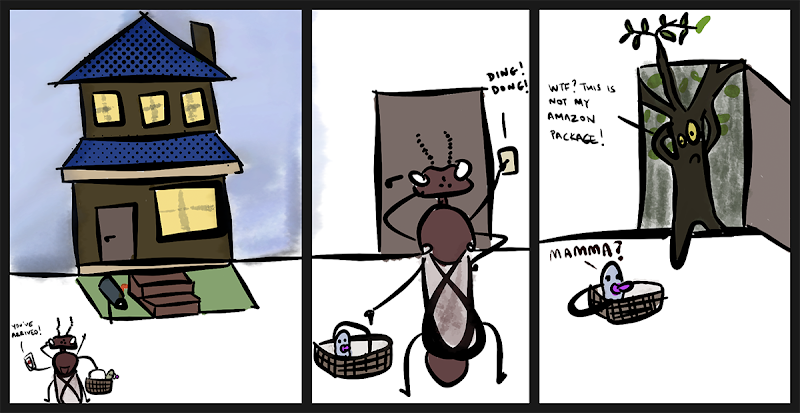Hello folks who wonder if alcoholics just got another reason to postpone curbing their binge drinking habits because 12-step programs are suspended due to social distancing,
Imagine you are walking down the street to drop your kid to daycare and you see something on the ground. So you bend over carefully to pick it up, because of the perennial back pain y'know, and find a credit card that belongs to someone by the name Jeff Bezos. So your initial thought of let me return this to the bank quickly changes to let me hold on to this card for a while, since those minor charges won't break the bank for the world's richest person.
So you pay the daycare expenses with that card, and then put your kid into private school and later into a private university, all while using that card.
Chances are Mr. Amazon won't be checking his credit card statements for these suspicious charges and well, you have successfully raised a kid without spending a single dim of yours.
Similarly in nature, some organisms will rely on other adoptive organisms to raise their offspring without causing too much strain on the resources of the adoptive parent. One such example of this behavior is found in galls.
You see, galls look like tumorous growth in a plant that comes in various shapes and sizes occurring at different parts of the plant like leaves, stems or roots.
These can be caused by organisms like insects, fungi, bacteria and more.
Below is an example of one kind of gall commonly visible on the Coyote Brush plant.
This is the way it works: The parent who is not related to the plant in any way, drops off her eggs at any part of the plant. The plant who now mistakes the chemical secretion around the babies as an infection and wants to isolate it. So it will trigger an unusual plant cell growth in that area(Social distancing before it was cool!). Thus these structures that form will happily shelter the babies who will spend their childhood munching on these plant tissues and transition to adulthood, before climbing out of the the gall structure and starting the cycle all over again.
Below is how it usually happens.
One of the most common types of galls you might be familiar with are the Oak apples which are commonly found on the Valley Oaks. These are caused by a wasp aptly called the California Gall Wasp.
One Oak apple can have either one or more babies in it. Talk about having to share your room with siblings.
Below is an adult California Gall Wasp on an Oak Apple pondering if it should take the AncestryDNA test to find out more about its biological parent(s).
Coming back to the gall commonly found on the Coyote Brush plant, it is caused by a fly called the Coyote Brush Bud Gall Midge. One can identify the insects inside a gall without peeking because different insects form different kinds of galls.
Also you can tell if the adult insect has emerged by observing tiny holes on either sides of the gall.
Below is the larva of a Coyote Brush Bud Gall Midge wondering who turned on the lights.
Who doesn't like free day care and free food. Even though, these larvae are protected from the elements, they are still not safe from parasites. Parasitoid wasps will inject their eggs in the galls, so once their eggs hatch, they will start devouring the larva of the Coyote Brush Bud Gall Midge.
Below you can see a parasitoid larva on the Gall midge larva, munching on its breakfast while enjoying a ride.
Imagine you are walking down the street to drop your kid to daycare and you see something on the ground. So you bend over carefully to pick it up, because of the perennial back pain y'know, and find a credit card that belongs to someone by the name Jeff Bezos. So your initial thought of let me return this to the bank quickly changes to let me hold on to this card for a while, since those minor charges won't break the bank for the world's richest person.
So you pay the daycare expenses with that card, and then put your kid into private school and later into a private university, all while using that card.
Chances are Mr. Amazon won't be checking his credit card statements for these suspicious charges and well, you have successfully raised a kid without spending a single dim of yours.
Similarly in nature, some organisms will rely on other adoptive organisms to raise their offspring without causing too much strain on the resources of the adoptive parent. One such example of this behavior is found in galls.
You see, galls look like tumorous growth in a plant that comes in various shapes and sizes occurring at different parts of the plant like leaves, stems or roots.
These can be caused by organisms like insects, fungi, bacteria and more.
Below is an example of one kind of gall commonly visible on the Coyote Brush plant.
Below is how it usually happens.
One Oak apple can have either one or more babies in it. Talk about having to share your room with siblings.
Below is an adult California Gall Wasp on an Oak Apple pondering if it should take the AncestryDNA test to find out more about its biological parent(s).
Also you can tell if the adult insect has emerged by observing tiny holes on either sides of the gall.
Below is the larva of a Coyote Brush Bud Gall Midge wondering who turned on the lights.
Below you can see a parasitoid larva on the Gall midge larva, munching on its breakfast while enjoying a ride.






No comments:
Post a Comment
Did you learn something new in this post? Let us know in the comments below